Part of a series of articles titled Park Air Profiles.
Article
Park Air Profiles - Olympic National Park
Air Quality at Olympic National Park
Most visitors expect clean air and clear views in parks. While air quality in Olympic National Park (NP), Washington, is relatively good, the east side of the park may be affected by emissions from populated and industrialized areas along the Puget Sound, including the Seattle metropolitan area and marine vessel traffic in the Strait of Juan De Fuca. Additionally, air masses originating in Asia transport pollutants across the Pacific Ocean and into the park (Yu et al. 2012). The National Park Service works to address air pollution effects at Olympic NP, and in parks across the U.S., through science, policy and planning, and by doing our part.
Nitrogen and Sulfur
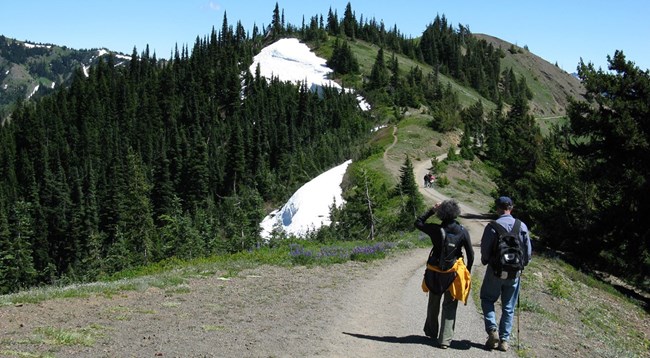
Nitrogen (N) and sulfur (S) compounds deposited from the air may have harmful effects on ecosystem processes. Healthy ecosystems can naturally buffer a certain amount of pollution, but once a threshold is passed the ecosystem may respond negatively. This threshold is the critical load, or the amount of pollution above which harmful changes in sensitive ecosystems occur (Porter 2005). N and S deposition change ecosystems through eutrophication (N deposition) and acidification (N + S deposition). Eutrophication increases soil and water nutrients which causes some species to grow more quickly and changes community composition. Ecosystem sensitivity to nutrient N enrichment at Olympic National Park (OLYM) relative to other national parks is very high (Sullivan et al. 2016); for a full list of N sensitive ecosystem components, see: NPS ARD 2019. Acidification leaches important cations from soils, lakes, ponds, and streams which decreases habitat quality. Ecosystem sensitivity to acidification at OLYM relative to other national parks is very high (Sullivan et al. 2016); to search for acid-sensitive plant species, see: NPSpecies.
From 2017-2019 total N deposition in OLYM ranged from 1.5 to 3.5 kg-N ha-1 yr-1 and total S deposition ranged from 1.1 to 3.4 kg-S ha-1 yr-1 based on the TDep model (NADP, 2018). OLYM has been monitoring atmospheric N and S deposition since 1980, see the conditions and trends website for park-specific information.
Lakes and streams in OLYM are generally well-buffered from acidification, in part due to high rates of weathering and the chemical composition of local geology (Naiman et al. 1986).
Alpine ecosystem effects
Alpine environments are particularly vulnerable to large inputs of reactive nitrogen because of the sparse cover of vegetation, short growing seasons, large areas of exposed bedrock and talus, and snowmelt nutrient releases (Williams et al., 1996; Nanus et al., 2012). Approximately 2% of the land area in OLYM is alpine (~328 km2 above 1550 m). McClung et al. (2021) compared the 2015 estimated total N deposition (TDep; NADP, 2018) to the critical load of N for an increase in alpine sedge growth (alpine plant critical load = 3 kg-N ha-1yr-1) and the critical load of N for alpine soil nitrate leaching (alpine soil critical load = 10 kg-N ha-1yr-1; Bowman et al., 2012). They found that deposition exceeded the alpine plant critical load in 18% of the alpine area, but was below the alpine soil critical load throughout the park’s entire alpine area.
Epiphytic macrolichen community responses
Epiphytic macrolichens grow on tree trunks, branches, and boles. Since these lichens grow above the ground, they obtain all their nutrients directly from precipitation and the air. Many epiphytic lichen species have narrow environmental niches and are extremely sensitive to changes in air pollution. Geiser et al. (2019) used a U.S. Forest Service national survey to develop critical loads of nitrogen (N) and critical loads of sulfur (S) to prevent more than a 20% decline in four lichen community metrics: total species richness, pollution sensitive species richness, forage lichen abundance, and cyanolichen abundance.
McCoy et al. (2021) used forested area from the National Land Cover Database to estimate the impact of air pollution on epiphytic lichen communities. Forested area makes up 2969 km2 (80.2%) of the land area of Olympic National Park.
- N deposition exceeded the 3.1 kg-N ha-1 yr-1 critical load to protect N-sensitive lichen species richness in 1.5% of the forested area.
- S deposition exceeded the 2.7 kg-S ha-1 yr-1 critical load to protect S-sensitive lichen species richness in 57.2% of the forested area.
For exceedances of other lichen metrics and the predicted decline of lichen communities see Appendices A and B of McCoy et al. (2021).
Additional modeling was done on 459 lichen species to test the combined effects of air pollution and climate gradients (Geiser et al. 2021). A critical load indicative of initial shifts from pollution-sensitive toward pollution-tolerant species occurred at 1.5 kg-N ha-1 yr-1 and 2.7 kg-S ha-1 yr-1 even under changing climate regimes.
Plant species response
Plants vary in their tolerance of eutrophication and acidification, and some plant species respond to nitrogen (N) or sulfur (S) pollution with declines in growth, survival, or abundance on the landscape. Horn et al. (2018) used the U.S. Forest Service national forest survey to develop critical loads of N and critical loads of S to prevent declines in growth or survival of sensitive tree species. Clark et al. (2019) used a database of plant community surveys to develop critical loads of N and critical loads of S to prevent a decline in abundance of sensitive herbaceous plant species. According to NPSpecies, Olympic National Park contains:
- 9 N-sensitive tree species and 30 N-sensitive herbaceous species.
- 8 S-sensitive tree species and 22 S-sensitive herbaceous species.
Mycorrhizal fungi community response
Many plants have a symbiotic relationship with mycorrhizal fungi (MF). Through the roots, the plants supply the fungi with carbon from photosynthesis and in exchange the MF enhance nutrient availability within soils, increase drought tolerance, and provide physical resistance to soil erosion (George et al., 1995; Cheng et al., 2021; Burri et al., 2013). Anthropogenic Nitrogen (N) deposition can disrupt this symbiotic relationship resulting in a shift from N sensitive to N tolerant mycorrhizal fungi and plant communities.
With increased N deposition to the soil, MF become less important for nutrient uptake and many plants will cease the exchange of nutrients altogether making them more vulnerable to stressors such as drought (Lilleskov et al., 2019). The CL-N for the shift in mycorrhizal community is 5-6 kg-N ha-1 yr-1 in coniferous forests and 10-20 kg-N ha-1 yr-1 broadleaf forests.
Olympic National Park has 3283.1 km2 of coniferous forests, 6.7 km2 of broadleaf forests, and 7.6 km2 of mixed forests. Using the range in critical loads above, the minimum CL is exceeded in 0% of forested area and the maximum CL is exceeded in 0% of forested area based on 2019-2021 TDep Total N deposition.
Change in N and S deposition from 2000 to 2021
The maps below show how the spatial distribution of estimated Total N and Total S deposition in OLYM has changed from 2000-2002 to 2019-2021 (TDep MMF version 2022.02). Slide the arrows in the middle of the image up and down to compare N and S deposition between the two years (Yearly Data).
- Minimum N deposition decreased from 2.4 to 1.4 kg-N ha-1 yr-1 and maximum N deposition decreased from 4.3 to 3.5 kg-N ha-1 yr-1.
- Minimum S deposition decreased from 3.5 to 0.8 kg-S ha-1 yr-1 and maximum S deposition decreased from 7.2 to 3.4 kg-S ha-1 yr-1.
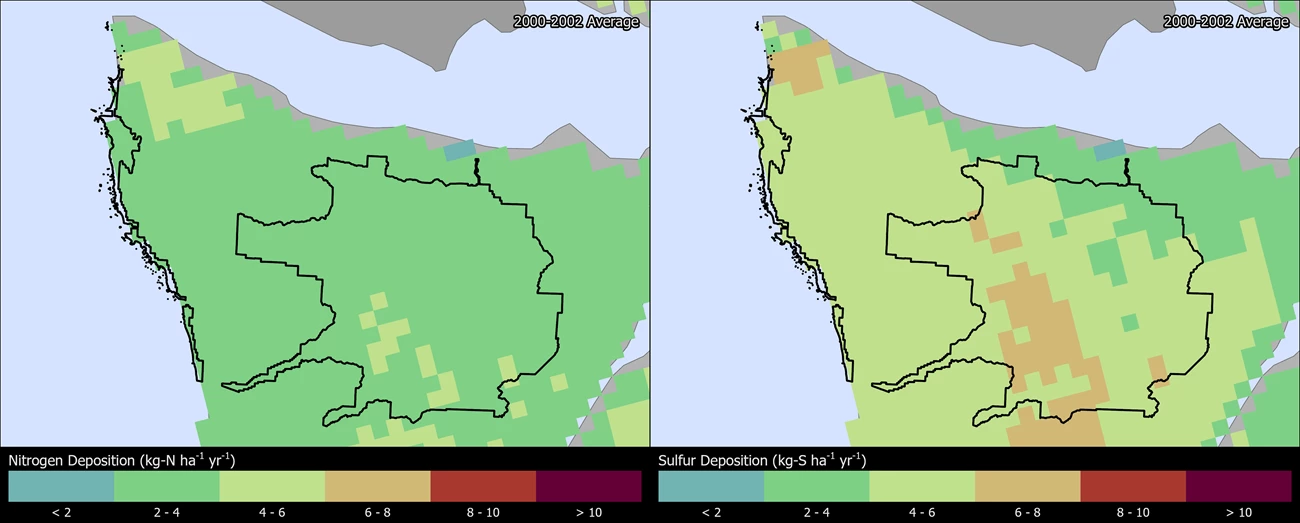
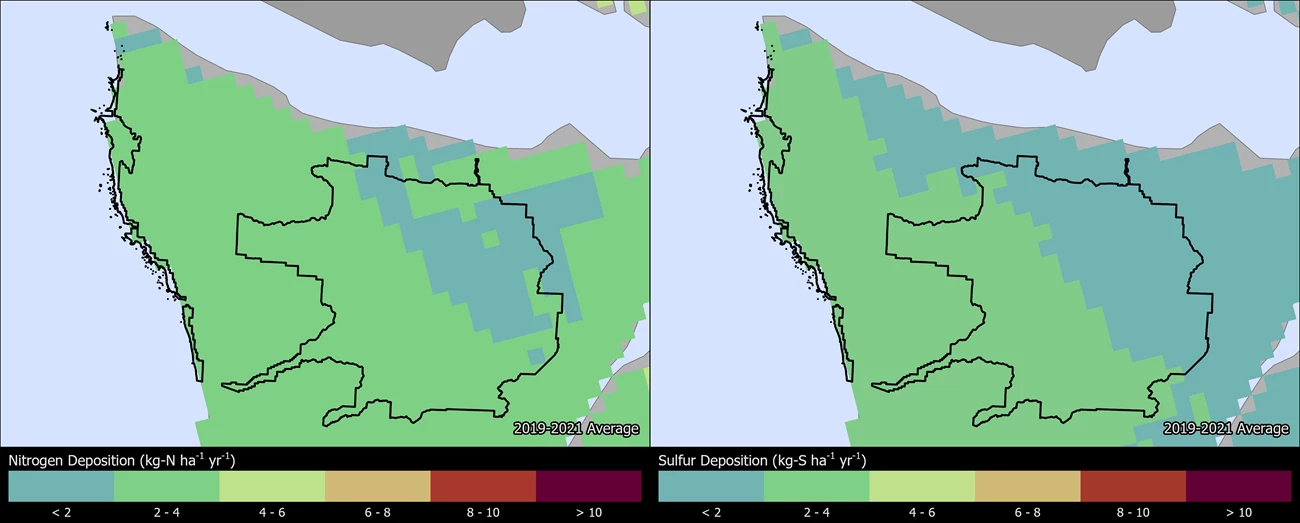
Persistent Pollutants
Pollutants like mercury and pesticides are concerning because they are persistent and toxic in the environment. These contaminants can travel in the air thousands of miles away from the source of pollution, even depositing in protected places like national parks. In addition, while some of these harmful pollutants may be banned from use, historically contaminated sites continue to endure negative environmental consequences.
When deposited, airborne mercury and other toxic air contaminants are known to harm wildlife like birds and fish, and cause human health concerns. Many of these substances enter the food chain and accumulate in the tissue of organisms causing reduced reproductive success, impaired growth and development, and decreased survival.
- Mercury concentrations in some fish (brook and cutthroat trout) sampled at Olympic NP exceeded the threshold for bird toxicity, but not fish toxicity or US EPA’s human consumption guidance. Fish were sampled and analyzed for mercury from five sites sampled at the park and compared to data across 21 western parks. The average fish mercury concentration (85.0 ng/g ww) was slightly higher than the study-wide mean (77.7 ng/g ww). Mercury concentrations exceeded the threshold for bird toxicity in 6% of fish sampled (Eagles-Smith et al. 2014). However, the data may not reflect the risk at other unsampled locations in the park.
- Fish consumption advisories issued at Olympic NP due to elevated levels of mercury. An advisory for recreational and subsistence fish consumption remains in effect for Olympic NP’s mountain lakes (brook trout) and Lake Ozette (largemouth bass, yellow perch and northern pikeminnow) (OLYM 2021). Other advisories may be in effect for mercury and other contaminants (NPS 2022). Fish with elevated mercury concentrations and fish from contaminated lakes displayed symptoms like tissue damage (Landers et al. 2010; Landers et al. 2008; Moran et al. 2007; Schwindt et al. 2008).
- Some dragonfly larvae sampled at the park had mercury concentrations at moderate or higher impairment levels. Dragonfly larvae have been sampled and analyzed for mercury from 14 sites in the park; 67% of the data fall into the moderate (100-300 ng/g dw) and 26% fall into the high/severe (>300 ng/g dw) impairment categories for potential mercury risk. An index of moderate impairment or higher suggests some fish may exceed the US EPA benchmark for protection of human health (Eagles-Smith et al. 2020; Eagles-Smith et al. 2018).
- Related studies also found mercury and other contaminants in park snow, sediment, vegetation, and fish. Contaminants include mercury, current-use pesticides, historic-use pesticides, and industrial by-products (Flanagan Pritz et al. 2014; Frenzel et al. 1990; Furl et al. 2009; Hageman et al. 2006). A Natural Resource Condition Assessment for Olympic NP suggests that the park has a mosaic of mercury sensitive habitats and species that would benefit from continued monitoring and further studies (McCaffrey et al. 2018). Evidence suggests nearshore tree cover and fish diet account for the most variance in fish mercury at Olympic (Chiapella et al. 2021).
The NPS Air Resources Division reports on park conditions and trends for mercury. Visit the webpage to learn more.
Visibility
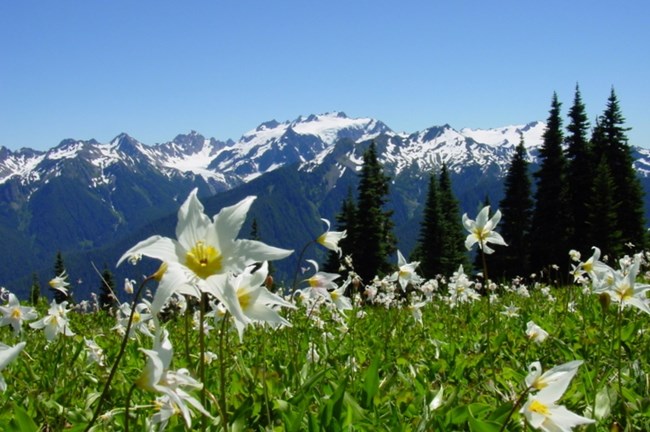
Many visitors come to Olympic NP to enjoy views of the rugged Olympic Mountains. Park vistas are sometimes obscured by haze, reducing how well and how far people can see. Visibility reducing haze is caused by tiny particles in the air, and these particles can also affect human health. Many of the same pollutants that ultimately fall out as nitrogen and sulfur deposition contribute to this haze. Organic compounds, soot, dust, sea salt aerosols, and wood smoke reduce visibility as well. Significant improvements in park visibility have been documented since the 2000’s. Still, visibility in the park needs improvement to reach the Clean Air Act goal of no human caused impairment.
Visibility effects:
- Reduction of the average natural visual range from about 140 miles (without the effects of pollution) to about 115 miles because of pollution at the park
- Reduction of the visual range from about 105 miles to below 65 miles on high pollution days.
- A 1990 study called PREVENT, the Pacific Northwest Regional Visibility Experiment Using Natural Tracers, found that sulfur (largely from power plants and urban emissions) is the largest contributor to reduced visibility at Olympic NP. Nitrates also contributed about 10% of the visibility reduction at the park and are mostly from emissions from pulp and paper mills or lime-kiln activity, fires, power plants, and transportation (Malm et al. 1994).
Visit the NPS air quality conditions and trends website for park-specific visibility information. Olympic NP has been monitoring visibility since 2001. Check out the live air quality webcam and explore air monitoring »
Ground-Level Ozone
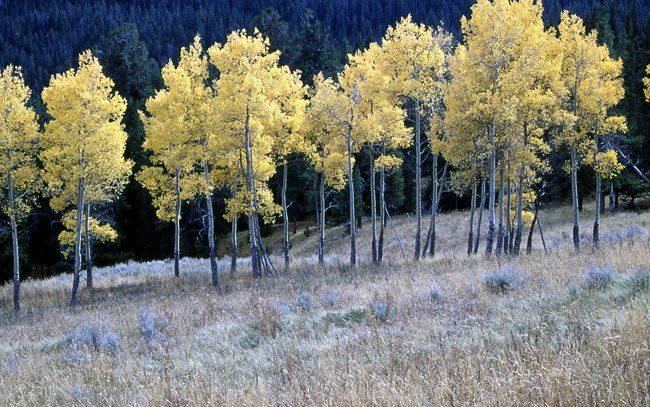
At ground level, ozone is harmful to human health and the environment. Ground-level ozone does not come directly from smokestacks or vehicles, but instead is formed when other pollutants, mainly nitrogen oxides and volatile organic compounds, react in the presence of sunlight. Ozone is transported to Olympic NP from the Puget Sound urban zone and trans-Pacific sources (Barna et al. 2000; Jaffe et al. 2003). Marine vessel traffic in the Strait of Juan De Fuca also contributes to ozone pollution in the region. However, ozone transport is limited and the Olympic Peninsula still has some of the lowest measured ozone concentrations in the Western U.S. (Bohm 1992).
Over the course of a growing season, ozone can damage plant tissues making it harder for plants to produce and store food. It also weakens plants making them less resistant to disease and insect infestations. Some plants are more sensitive to ozone than others. While several park species, including Populus tremuloides (quaking aspen) and Vaccinium membranaceum (thin leaved huckleberry) are known to be sensitive to ozone, concentrations at the park are below levels known to be harmful to plants (Eilers et al. 1994). Search additional ozone-sensitive plant species found at Olympic NP.
Visit the NPS air quality conditions and trends website for park-specific ozone information.
Explore Other Park Air Profiles
There are 47 other Park Air Profiles covering parks across the United States and its territories.
References
Barna, M., Lamb, B., O’Neill, S., Westberg, H., Figueroa-Kaminsky, C. Otterson, S., Bowman, C., and DeMay, J. 2000. Modeling Ozone Formation and Transport in the Cascadia Region of the Pacific Northwest. Journal of Applied Meteorology 39: 349–366.
Bohm, M. 1992. Air Quality and Deposition. In: Olson, R. K., Binkley, D. and Bohm, M. (eds). The Response of Western Forests to Air Pollution. Springer-Verlag: New York, NY. pp. 63–152.
Bowman W, Murgel J, Blett T, Porter E. 2012. Nitrogen critical loads for alpine vegetation and soils in Rocky Mountain National Park. Journal of Environmental Management. 103:165-171
Burri, K., C. Gromke, and F. Graf. "Mycorrhizal fungi protect the soil from wind erosion: a wind tunnel study." Land Degradation & Development 24.4 (2013): 385-392.
Cheng, Shen, et al. "Elucidating the mechanisms underlying enhanced drought tolerance in plants mediated by arbuscular mycorrhizal fungi." Frontiers in Microbiology 12 (2021): 809473.
Chiapella, A.M., Eagles-Smith, C.A. and Strecker, A.L. 2021. From forests to fish: Mercury in mountain lake food webs influenced by factors at multiple scales. Limnol Oceanogr, 66: 1021-1035. https://doi.org/10.1002/lno.11659
Clark, C.M., Simkin, S.M., Allen, E.B. et al. Potential vulnerability of 348 herbaceous species to atmospheric deposition of nitrogen and sulfur in the United States. Nat. Plants 5, 697–705 (2019). https://doi.org/10.1038/s41477-019-0442-8
Eagles-Smith, C.A., J.J. Willacker, and C.M. Flanagan Pritz. 2014. Mercury in fishes from 21 national parks in the Western United States—Inter and intra-park variation in concentrations and ecological risk: U.S. Geological Survey Open-File Report 2014-1051, 54 p. Available at: http://dx.doi.org/10.3133/ofr20141051
Eagles-Smith, C.A., J.J. Willacker, S.J. Nelson, C.M. Flanagan Pritz, D.P. Krabbenhoft, C.Y. Chen, J.T. Ackerman, E.H. Campbell Grant, and D.S. Pilliod. 2020. Dragonflies as biosentinels of mercury availability in aquatic food webs of national parks throughout the United States. Environmental Science and Technology 54(14):8779-8790. https://doi.org/10.1021/acs.est.0c01255
Eagles-Smith, C.A., S.J. Nelson., C.M. Flanagan Pritz, J.J. Willacker Jr., and A. Klemmer. 2018. Total Mercury Concentrations in Dragonfly Larvae from U.S. National Parks (ver. 6.0, June 2021): U.S. Geological Survey data release. https://doi.org/10.5066/P9TK6NPT
Eilers, J. M., Rose, C. L., Sullivan, T. J. 1994. Status of Air Quality and Effects of Atmospheric Pollutants on Ecosystems in the Pacific Northwest Region of the National Park Service. NPS Final Report. 255 pp. Available at https://irma.nps.gov/DataStore/Reference/Profile/547259.
Flanagan Pritz, C. M., J. E. Schrlau, S. L. Massey Simonich, T. F. Blett. 2014. Contaminants of Emerging Concern in Fish from Western U.S. and Alaskan National Parks – Spatial Distribution and Health Thresholds. Journal of American Water Resources Association 50 (2): 309–323. Available at https://irma.nps.gov/App/Reference/Profile/2210538.
Frenzel, R. W., Witmer, G. W. and Starkey, E. E. 1990. Heavy metal concentrations in a lichen of Mt. Rainier and Olympic National Parks, Washington, USA. Bulletin of Environmental Contamination and Toxicology 44 (1): 158–164. https://irma.nps.gov/DataStore/Reference/Profile/60167
Furl, C. V., Colman, J. A., Bothner, M. H. 2009. Mercury Sources to Lake Ozette and Lake Dickey: Highly Contaminated Remote Coastal Lakes, Washington State, USA. Water Air Soil Pollut 208: 275–286. https://irma.nps.gov/DataStore/Reference/Profile/662556
Geiser, Linda & Nelson, Peter & Jovan, Sarah & Root, Heather & Clark, Christopher. (2019). Assessing Ecological Risks from Atmospheric Deposition of Nitrogen and Sulfur to US Forests Using Epiphytic Macrolichens. Diversity. 11. 87. 10.3390/d11060087.
Geiser, Linda & Root, Heather & Smith, Robert & Jovan, Sarah & Clair, Larry & Dillman, Karen. (2021). Lichen-based critical loads for deposition of nitrogen and sulfur in US forests. Environmental Pollution. 291. 118187. 10.1016/j.envpol.2021.118187.
George, Eckhard, Horst Marschner, and Iver Jakobsen. "Role of arbuscular mycorrhizal fungi in uptake of phosphorus and nitrogen from soil." Critical reviews in biotechnology 15.3-4 (1995): 257-270.
Hageman, K. J., Simonich, S. L., Campbell, D. H., Wilson, G. R., Landers, D. H. 2006. Atmospheric deposition of current-use and historic-use pesticides in snow at national parks in the Western United States. Environmental Science & Technology 40: 3174–3180. https://irma.nps.gov/DataStore/Reference/Profile/648369
Horn KJ, Thomas RQ, Clark CM, Pardo LH, Fenn ME, Lawrence GB, et al. (2018) Growth and survival relationships of 71 tree species with nitrogen and sulfur deposition across the conterminous U.S.. PLoS ONE 13(10): e0205296. https://doi.org/10.1371/journal.pone.0205296
Jaffe, D., McKendry, I., Anderson, T., Price, H. 2003. Six ‘new’ episodes of trans-Pacific transport of air pollutants. Atmos. Envir. 37: 391–404.
Landers, D. H., S. L. Simonich, D. A. Jaffe, L. H. Geiser, D. H. Campbell, A. R. Schwindt, C. B. Schreck, M. L. Kent, W. D. Hafner, H. E. Taylor, K. J. Hageman, S. Usenko, L. K. Ackerman, J. E. Schrlau, N. L. Rose, T. F. Blett, and M. M. Erway. 2008. The Fate, Transport, and Ecological Impacts of Airborne Contaminants in Western National Parks (USA). EPA/600/R—07/138. U.S. Environmental Protection Agency, Office of Research and Development, NHEERL, Western Ecology Division, Corvallis, Oregon. Available at https://irma.nps.gov/DataStore/Reference/Profile/660829
Landers, D. H., Simonich, S. M., Jaffe, D., Geiser, L., Campbell, D. H., Schwindt, A., Schreck, C., Kent, M., Hafner, W., Taylor, H. E., Hageman, K., Usenko, S., Ackerman, L., Schrlau, J., Rose, N., Blett, T., Erway, M. M. 2010. The Western Airborne Contaminant Assessment Project (WACAP): An Interdisciplinary Evaluation of the Impacts of Airborne Contaminants in Western U.S. National Parks. Environmental Science and Technology 44: 855–859. Available at https://pubs.acs.org/doi/10.1021/es901866e
Lilleskov, Erik A., et al. "Atmospheric nitrogen deposition impacts on the structure and function of forest mycorrhizal communities: a review." Environmental Pollution 246 (2019): 148-162.
Malm, W. C., Gebhart, K. A., Molenar, J., Eldred, R., Harrison, H. 1994. Pacific Northwest Regional Visibility Experiment Using Natural Tracers—PREVENT. National Park Service Final Report. Available at http://vista.cira.colostate.edu/Improve/final-report-prevent/.
McCaffery, R., and K. Jenkins (Eds.). 2018. Natural resource condition assessment: Olympic National Park. Natural Resource Report NPS/OLYM/NRR—2018/1826. National Park Service, Fort Collins, Colorado. https://irma.nps.gov/DataStore/DownloadFile/610305
Moran P. W., Aluru, N., Black, R. W., Vijayan, M. M. 2007. Tissue contaminants and associated transcriptional response in trout liver from high elevation lakes of Washington. Environ Sci Technol. 41(18): 6591–6597. https://irma.nps.gov/DataStore/Reference/Profile/660777
McClung JJ, Bell MD, Felker-Quinn E. 2021. Extrapolating critical loads of nitrogen for alpine vegetation and assessing exceedance in national parks based on TDep Total N from 2002–2016. Natural Resource Report. NPS/NRSS/ARD/NRR—2021/2240. National Park Service. Fort Collins, Colorado. https://doi.org/10.36967/nrr-2284914
McCoy K., M. D. Bell, and E. Felker-Quinn. 2021. Risk to epiphytic lichen communities in NPS units from atmospheric nitrogen and sulfur pollution: Changes in critical load exceedances from 2001‒2016. Natural Resource Report NPS/NRSS/ARD/NRR—2021/2299. National Park Service, Fort Collins, Colorado. https://doi.org/10.36967/nrr-2287254.
[NADP] National Atmospheric Deposition Program. 2018. NTN Data. Accessed January 20, 2022. Available at http://nadp.slh.wisc.edu/NADP/
Naiman, R. J., J. M. Melillo, and J. E. Hobbie. 1986. Ecosystem alteration of boreal forest streams by beaver (Castor canadensis). Ecology 67:1254–1269.
Nanus L, Clow D, Saros J, Stephens V, Campbell D. 2012. Mapping Critical Loads of Nitrogen Deposition for Aquatic Ecosystems in the Rocky Mountains, USA.. Environmental Pollution. 166:125-135
[NPS] National Park Service. 2022. Fish Consumption Advisories. https://www.nps.gov/subjects/fishing/fish-consumption-advisories.htm
[OLYM] Olympic National Park. 2021. Fish & Shellfish Regulations. National Park Service Brochure. https://www.nps.gov/olym/planyourvisit/upload/OLYM_Fishing_Brochure_508-Compliant_2021-update-3-3.pdf
Porter, E., Blett, T., Potter, D.U., Huber, C. 2005. Protecting resources on federal lands: Implications of critical loads for atmospheric deposition of nitrogen and sulfur. BioScience 55(7): 603–612. https://doi.org/10.1641/0006-3568(2005)055[0603:PROFLI]2.0.CO;2
Schwindt, A. R., Fournie, J. W., Landers, D. H., Schreck, C. B., Kent, M. 2008. Mercury Concentrations in Salmonids from Western U.S. National Parks and Relationships with Age and Macrophage Aggregates. Environmental Science & Technology 42 (4): 1365–1370. https://irma.nps.gov/DataStore/Reference/Profile/664114
Sullivan, T. J. 2016. Air quality related values (AQRVs) in national parks: Effects from ozone; visibility reducing particles; and atmospheric deposition of acids, nutrients and toxics. Natural Resource Report NPS/NRSS/ARD/NRR—2016/1196. National Park Service, Fort Collins, CO.
Williams MW, Baron JS, Caine N, Sommerfeld R, Sanford R. 1996. Nitrogen saturation in the Rocky Mountains. Environmental Science & Technology. 30(2):640-646
Last updated: July 24, 2024
